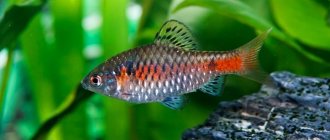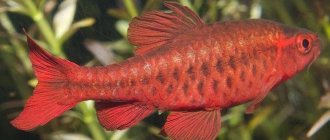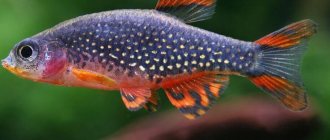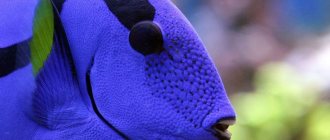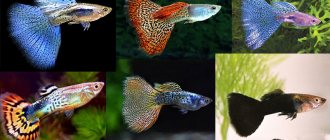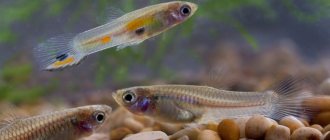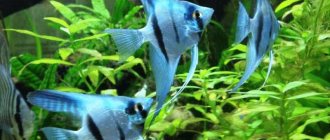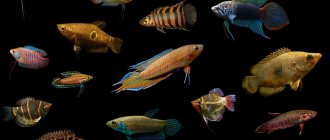The scarlet barb or Odessa barb (Latin Pethia padamya, English Odessa barb) is a very beautiful aquarium fish, but less popular than its relatives - the cherry and Sumatran barbs. Finding it on sale often takes some effort. Too rarely you can find it at the market, in a pet store or on the endless Internet. This is a bright, peaceful and rather unpretentious fish that can be kept in a community aquarium and will serve as its decoration.
Description of the fish
The scarlet barb, or puntius-ticto, is a popular representative of the order Cyprinidae, the carp family. A schooling, spawning small freshwater fish. Easily adapts to different living conditions.
Origin
Puntius tikto was brought to European countries from Southeast Asia in 1903. The species was not immediately popular, but over time it spread throughout the continent.
It is believed that the first wild fish were caught in a mountain river in Burma at an altitude of 3000 meters.
In the 70s, by sea from Vietnam, the first specimens of the scarlet barb arrived on the territory of the Soviet Union, in the city of Odessa.
Barbs were brought to the USSR by sea through Odessa
Local aquarists began to actively breed a new species, which soon received a second name - Odessa barb (Odessa).
Habitat
In its natural habitat, the scarlet puntius inhabits the water bodies of the Republic of Myanmar, India, Thailand and the Himalayas.
The aquatic systems in the area of scarlet barbs are characterized by:
- rivers flowing through calcareous rocks of mountainous areas (water with high levels of hardness);
- rocky, silty substrates;
- a small number of plants in a pond.
Fish that live in their natural environment live in small schools of about 20 individuals.
Habitat in nature
The scarlet barb lives in Myanmar, in the Irrawaddy River and its tributaries. Typical bodies of water in which it is found are backwaters and dams of large and medium-sized rivers.
The bottom in such places is muddy, and the barb spends a lot of time searching for food at the bottom.
There are problems with the history of the appearance of this species on the territory of the former USSR. In the English-speaking world it is called Odessa barb, because it is believed that these fish were first bred in Odessa.
At the same time, this species is often confused with another, similar species - the tikto barb. Moreover, the confusion even applies to Wikipedia.
For example, in the English and Russian parts describing Tikto, there are two different fish in the photo.
Keeping in an aquarium
Puntius are unpretentious fish, and therefore keeping them brings only pleasure. To do this, you need a spacious tank with a clean, oxygenated aquatic environment. In addition, the Tikto barb loves a slight current, as in its natural habitat.
Aquarium
Scarlet Puntius is a schooling fish, and to prevent your pet from getting bored in the aquarium alone, it is recommended to purchase at least 6 representatives of the same species. Otherwise, the ticks will experience stressful and painful conditions - the color will fade and mobility will decrease.
Aquariums for barbs should have an elongated, elongated shape
When setting up a home ecosystem for scarlet puntius, you must adhere to the following rules:
- Aquarium volume from 50 liters.
- Preference should be given to a panoramic design - with a length of 60 cm.
- The front and center of the aquarium should be left free for swimming.
- It is better to plant decorations and vegetation on the sides and at the back wall.
- The tank is equipped with a lid to prevent excessive evaporation and to prevent nimble pets from accidentally jumping out.
Preference should be given to classic rectangular shapes. In such aquariums there are no visual distortions and it is easier to hide connected equipment.
Water parameters
The scarlet barb quickly adapts to different conditions. Only gross deviations or sharp changes from maximum or minimum values can be critical.
Optimal physical and chemical parameters:
- temperature – 20-25 °C;
- acidity – 6.5-7 pH;
- hardness – 5-20 dH;
Water changes (¼ part) are carried out regularly - once every 7 days.
Plants
Tikto barbs are kept in an aquarium with live vegetation. Planted in the ground or free-floating crops play an important role in the life of the fish:
- They are an additional power source.
- Perform a gas exchange function.
- Serves as a reliable shelter.
- Shade bright lighting.
- They indirectly participate in spawning.
Plants in a barb aquarium should not interfere with the fish’s frolic.
Plants can be planted to suit your taste, but it is important not to forget that scarlet puntius will eat tender shoots and dig up the soil, which will damage aquacultures with a weak root system.
Small-leaved and long-stemmed vegetation is suitable for scarlet barbs:
- Anubias;
- elodea;
- pistia;
- hornwort;
- salvinia;
- Echinodorus;
- Vallisneria;
- lemongrass;
- cryptocoryne;
- hygrophila.
As a decorative component, the herbalist can be supplemented with artificial plants, but they cannot be completely replaced with a polymer analogue.
Where does the barb live?
Photo: Barbus fish
Regarding the Sumatran barb, this question is not relevant - from the name it is easy to guess that the main “registration” of this fish is the island of Sumatra and the regions of Southeast Asia nearby. The natural habitats of the fire barb are the water basins of northeastern India.
The main requirement that these bright and cheerful fish place on a pond is the absence of intense current - unpretentious barbs will populate a lake or pond with stagnant water. Rivers with weak currents are also suitable.
The homeland of the cherry barb is considered to be Southeast Asia (more specifically, the island of Sri Lanka). The fish lives (in fact, almost like all its relatives) in stagnant and sluggishly flowing reservoirs. Another criterion for the suitability of a reservoir is a dark, silty bottom.
The cherry barb first arrived in Europe in 1936, and in the USSR in 1959. Like the Sumatran, the red barius is a common resident in hobby aquariums. There is also an albino form of the cherry barb, but these individuals are considered mutants and are not in demand among aquarists. Some breeders sell them to beginners at exorbitant prices - under the guise of “rare tropical fish.” And this is where marketing comes in!
The above-mentioned Denisoni barb was originally discovered by the explorer whose name it immortalized in the waters of the Manimala River (near the city of Mundakayam, Kerala, southern India). The species is notable for being endemic to the Indian states of Kerala and Karnataka. Small populations can be found in the Valapatanam, Chalia and Kupam river basins.
But still, the main habitat of almost all representatives of the Barbus genus is the aquarium! An ideal aquarium for any barb should have an elongated, somewhat elongated shape (and in no case round) - this is necessary so that the frisky fish have the opportunity to “get up to speed.” The presence of floating plants, bright lighting, powerful filtration and aeration are necessary conditions for the successful breeding and maintenance of barbs.
Editor's note: Oliver Knott, who is he?
Compatibility
When choosing neighbors for scarlet barbs, it is important to remember the mobility of these wonderful fish. Puntiuses can cause a lot of trouble for slow and dignified phenotypes, constantly pestering their roommates.
Despite their mobility and lively nature, barbs themselves can become dinner for predatory fish, so co-population of punts with aggressive and large phenotypes should be avoided.
Compatible
Scarlet puntius demonstrates good compatibility with related species: fiery, Sumatran. A cherry barb or a Schubert barb will look especially impressive in an aquarium with scarlet. Its bright red dorsal fin will add contrast in a school of tiktos.
The cherry color of barbs looks bright and rich in the aquarium.
Scarlet barbs are also kept with other peace-loving fish:
- mollies;
- Congo;
- tetras;
- zebrafish;
- neon;
- labeo;
- swordtails;
- irises.
Large snails can also keep barbs company; fish will eat small mollusks.
Not compatible
Barbs often show hooligan tendencies - they bite the mustache and lush fins of representatives of a multi-species aquarium.
Compatibility table for barbs with other fish
Not recommended for keeping:
- large, aggressive predators;
- cockerels;
- angelfish;
- guppy;
- goldfish;
- gourami.
Small bottom fish are well compatible with barbs, but large catfish pose a threat to them.
Nutrition
In nature, they feed on worms, insects and other small invertebrates, as well as plants and organic debris. The aquarium will accept all types of high-quality dry and freeze-dried food, live and frozen foods with herbal supplements. A prerequisite for a balanced diet is a combination of all types of food; a monotonous diet will lead to a weakening of the color and immunity of the fish. Feed 2-3 times a day in an amount eaten within 5 minutes, any uneaten remains should be removed to prevent unnecessary contamination of the water.
Our product Aqvium natural dry food for small and medium fish from clean lakes of Siberia and Northern Crimea in environmentally friendly biodegradable packaging.
Find out more
Reproduction
Reproduction of scarlet barbs at home is simple and easy - to obtain the desired offspring, you only need a spawning tank and a couple of breeders.
A few weeks before breeding, the fish are switched to enhanced nutrition - the proportion of live protein feeds in the diet is increased.
Sex differences
Scarlet barbs are sexually mature at 8 months. Dimorphism is well expressed.
The table shows the differences between males and females.
| Size | Smaller | Larger |
| Body Shape | Elongated, flat | Wide and round |
| Iris eye | Red | Yellow |
| Scarlet stripe along the body | Pronounced, becomes even brighter during the spawning period | Weak, pigmentation practically disappears during spawning |
| Spots, streaks on fins | Bright, black | Pale, gray or absent |
Before spawning, the females’ belly thickens due to the maturation of the eggs and the anus swells. Males become brighter, more colorful and have an increased level of aggression.
Requirements for the spawning tank
The aquarium for spawning a couple of breeders should be from 20 liters. Its bottom must be covered with plants with small leaves, since spawning occurs among aquacultures. To prevent fish from eating the eggs, the tank can be equipped with a false bottom in the form of a large mesh.
Spawning tank for an aquarium in the form of a large mesh
To stimulate the reproduction of scarlet barbs, the following physical and chemical water parameters are established:
- temperature – 26 °C (or 2-4 °C higher than in a general aquarium);
- acidity – 6.5-7 pH;
- hardness – 6-7 dH.
The water level in the hatchery is no more than 17 cm, the lighting is dim, since barb eggs are sensitive to bright light.
It is recommended to darken part of the spawning area and install a compressor in the light area.
Breeding procedure
For reproduction, large females and the brightest males, who dominate the flock, are selected. Spawning of scarlet puntius usually occurs in the morning. After courtship and mating games, the female lays eggs, which are fertilized by the second parent. After the process is completed, the fish are transplanted into a common aquarium in order to preserve future offspring.
After 24-48 hours, the fry appear and the darkening is removed from the aquarium. After 3-4 days the fry begin to swim. At this time you need to start feeding them:
- living dust;
- ciliates;
- chopped worm.
Live dust for fry
Ciliates for feeding barb fry
Crushed worms for feeding fry
Barbus-tikto grows very quickly, after 30 days the fry reaches 1 cm in length. At 3 months, sex differences begin to be visible in the fish.
Breeding
For the scarlet barb fish, breeding is not a complicated process. If you plan to breed fish, you need to find the right ratio of females to males. There should be two females for every male. Many fish lovers are faced with the problem of correctly determining the sex. In fact, it is easiest to distinguish between males and females of this species after sexual maturity.
The fry become sexually mature at the age of 5-6 months.
Requirements for the spawning tank
- Although Odessa barbs can breed in a community aquarium, you will have a much better chance of success if you create a separate spawning aquarium. The only rule: it must be spacious.
- At the bottom of the aquarium, plant small-leaved plants on which the females will lay eggs.
- Hardness of water:
- Water temperature 25-27°C.
- pH of the environment: 6.5-6.8.
- To keep the fry safe, cover the bottom of the aquarium with a special mesh through which the eggs will pass.
- Breed in a densely planted aquarium where the babies will have plenty of hiding places. Plant, for example, a Thai fern, which will hide the young individuals.
Breeding procedure
- Before spawning, place the potential parents in a separate tank for 1-2 weeks and prepare them for breeding by feeding them high-protein food during this time.
- Females can lay up to 200 eggs in batches of 20 at a time. Spawning begins in the morning and lasts up to 4 hours.
- During breeding, females and males will move to the plants in the aquarium where the females will lay eggs on the leaves. Then, the males will fertilize each batch. This will continue until about 200 eggs have been released and fertilized.
- Since individuals can eat eggs, you need to remove the parents immediately after fertilization.
- The eggs will hatch within 24 hours and the fry will swim freely throughout the day.
- Once the babies are swimming freely, feed them small brine shrimp. As the offspring begin to grow, provide them with a variety of foods, including vegetables and live food.
- Thanks to good water quality and a nutritious diet, the fry grow within 30 days.
- Monitor the quality of water, as this is the most important component of the health of the offspring.
Diseases
The scarlet barb, like all members of the genus, has good immunity. Under favorable conditions, the fish practically does not get sick. But neglect of simple maintenance rules can lead to various kinds of diseases and even cost the life of any aquarium animal.
A viral, bacterial infection or parasitic form of protozoa introduced into the aquarium can cause in barbs:
- Ichthyophthyriosis. The causative agent is ciliated ciliates. A common infectious disease. It spreads quickly in the aquarium and appears as white dots and bumps on the cover (semolina effect). For treatment, table salt, potassium permanganate, copper sulfate, formalin, pharmaceuticals (tripaflavin, bicillin-5) or commercial drugs (TetraMedica Contralck, Sera Costapur, etc.) are used. For the period of therapy, increase the water temperature by 2-4 °C and increase aeration.
- Fin rot. Bacterial or parasitic infection of the cartilaginous swimming organ. In other cases, it occurs from traumatic factors, ammonia burns. It manifests itself as drooping, uneven edges, and over time - necrosis of the fin tissue. How to treat fin rot: hydrogen peroxide, streptocide, malachite green, furatsilin, chloramphenicol, etc.
- White-skinned. A bacterial disease manifested by the formation of white areas on the integument in the area of the dorsal and caudal fins. Over time, the overall color becomes pale and the central nervous system is affected. Treatment is carried out in the early stages with chloramphenicol.
Barbs are white-skinned
Fin rot
Fish affected by ichthyophthyriasis
The gluttony of scarlet barbs can cause obesity. This condition can significantly shorten the lifespan of any fish and provoke a whole range of associated pathologies. It is important to take a rational approach to the process of feeding barbs, defining one fasting day per week.
Aquarium lighting and filtration reduce the therapeutic effect. Medicines decompose faster from lamps, and filters with sorbing elements neutralize them.
Feeding
In the natural environment, the main food of barbs are small insects and their larvae, detritus, and soft parts of aquatic plants.
To enhance the color of your fish, you can use TetraRubin food.
In aquarium conditions, the Odessa barb, like its closest relatives, can eat both live and dry food. He willingly eats tubifex, small bloodworms, cyclops, and carriage. The diet can be varied with finely chopped shrimp and squid meat.
Don’t forget about the plant component – it should be at least 20%. This problem can be solved by purchasing a combination food that contains spirulina.
All barbs, including the scarlet one, are prone to gluttony. For this reason, portions must be strictly dosed, and this must be monitored especially carefully if children are feeding the fish.
Content Tips
Observations of the life of fish in captivity made it possible to identify practical recommendations for caring for them.
Content Features:
- Barbs are very sensitive to light. They may become stressed and hide even in good shade. It is recommended to use black primer and background. This will eliminate light reflection from the substrate and reduce the intensity of the lamp equipment.
- The artificial environment, dimmed from light, is similar to the natural habitat of puntius. Even in the twilight, the fish are clearly visible, their rhythm of life accelerates, they become more active and brighter.
- Sinking food will be preferable for punts. When they take food from the surface of the water, air enters the intestines and prevents them from swimming. This is not a pathological condition, but the fish become inert and sink to the bottom.
- It is recommended to pre-soak granulated food in water. It swells in the intestines and, if overeated, can lead to rupture of internal organs.
You can enhance the scarlet color of barbs with the help of specialized natural foods (Tetra Rubin and TetraPro Color and others).
Foods that enhance the color of barbs
Range and Habitat
Asia, has a limited range in the wild - Myanmar (formerly Burma).
The only known specimens are from central Myanmar, where they were collected from a man-made pond fed by a small stream in a village just above the Anisakan Falls called To Gyi, which is in Mandalay. They have also been reported in the lower reaches of the Chindwin River, a tributary of the Ayeyarwaddy.
This species lives in ponds and rivers. The specimens were caught at an altitude of about 3000 m above sea level.
The water was generally clear, flowing over limestone in some places, resulting in a pH as high as 11, there were no aquatic plants, and the bottom was covered with a mixture of loam and rocks.
Interesting Facts
Until the wild species was discovered in its natural habitat, the scarlet barb was considered a hybrid form.
In captivity, puntius are capable of:
- briefly withstand low and high water parameters from 16 to 30 ° C;
- in a pack, show a minimal level of aggression and experience stress less often;
- form a clear hierarchy in a group of relatives;
- acquire a feeding reflex if they are given food at the same time.
In female scarlet barbs, fertility is 150-200 eggs; individuals that do not lay eggs become infertile.
Appearance
The Odessa (scarlet) barb has an oval body, flattened on the sides and covered with large dense scales with a well-defined mesh pattern. The back is painted in greenish-gray tones, the belly is light, the sides are silver with a metallic tint. There are dark round spots just behind the gills and at the base of the tail. The fins are gray, translucent, decorated with clear black strokes.
Differences between males and females of the scarlet barb.
A distinctive feature of males is a wide red stripe running along the body . Sexual demorphism in this species is also expressed in the size of individuals and body structure: females are larger and rounder.
Reviews
Scarlet barbs are unpretentious fish that even a novice aquarist can keep and care for. Considering the endurance, energy and attractive appearance of the fish, many water enthusiasts acquire scarlet puntius, happily breeding these fish at home.Have you kept scarlet barbs? Would you like to start one? Share your thoughts in the comments.
Cost of scarlet barb
Scarlet barb is a budget breed of aquarium fish. The cost is not fixed and depends on the size:
- 1-2 cm – 50-70 rub.;
- 3 cm – 130 rub.;
- 4 cm – 150 rub.;
- 5 cm – 280 rub.
When choosing aquarium fish, pay attention to:
- Activity. Barbs that look lethargic in a container in a store are sick.
- Scales. If there are bald spots in the expressed mesh, discard such an individual.
